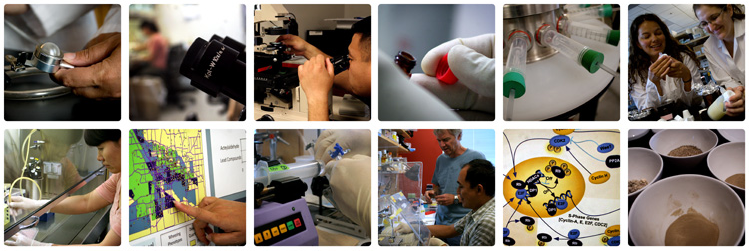Our Goal
Is to promote interdisciplinary research into the mechanisms by which environmental agents affect lung structure and function and lead to or exacerbate disease.
Our Focus
Is on toxicants that predominate in the Southwestern US, such as exposures to arsenic, particulate matter, and dusts.

Highlights from Our Research
A characterization of the immune profiles of Amish and Hutterite schoolchildren. The use of mouse models of asthma to study the effect of the environment on airway responses and to create a mechanistic framework for the interpretation of the observations in humans.
To learn more click here.
The association between urinary CC16 and soil arsenic may suggest that localized arsenic exposure in the lungs could damage the airway epithelium and predispose children for diminished lung function. The objective was to determine if urinary CC16 levels in children are associated with arsenic concentrations in environmental media collected from their homes.
To learn more click here.
Investigators from the University of Arizona Superfund Research Project (UA SRP) and the Southwest Environmental Health Sciences Center (SWEHSC) are partnering with an Arizona Tribe to develop an Air Quality and Asthma Project.
To learn more click here.
Studies led by PIs Lynn Gerald and Wayne Morgan:
A2DRC researchers and center members Drs. Gerald and Morgan received SWEHSC pilot funding to determine the efficacy of a simple, low-cost air cleaner at reducing levels of smoke in asthmatic children’s homes in which coal or wood is burned in traditional stoves. The air cleaner is being jointly designed and optimized by engineering students at UC Berkeley and Navajo Technical University. The preliminary data will support a NIEHS R01 application to the PAR “Intervention Research to Improve Native American Health”. The group recently gave a research update to the Asthma and Airways Disease Research Center and presented findings entitled “Reducing Household Air Pollution and Asthma Symptoms in Navajo Nation Children: Navajo Healthy Hooghans Project.”
To learn more about their work:
https://www.ncbi.nlm.nih.gov/pmc/articles/PMC6207133/
https://pubmed.ncbi.nlm.nih.gov/36570396/
This funded NIAID P01 investigates children’s susceptibility to asthma and other childhood illnesses in the US and Mexico through the first binational birth cohort. BEAMS will recruit 500 Mexican- American and Mexican pregnant women and their babies – 250 in Tucson, Arizona, and 250 in Nogales, Sonora, Mexico. The mothers will be evaluated while pregnant and the children will be followed from birth to age 5 to examine how the “hygiene hypothesis” affects them and their risk of asthma. Paradoxically, asthma rates are four times lower in Nogales than in Tucson, AZ—amidst poverty and underdevelopment in many ‘colonias’ in Nogales—likely because although children in Nogales are exposed to harmful bacteria that cause many infections, they are also exposed to protective bacteria that train their immune system to distinguish between dangerous and innocuous microbes. This work involves center members Drs. Martinez, Vercelli, Wright, Billheimer, and Beamer, and aims to determine 1) the microbes in Nogales, Sonora that protect children from asthma; 2) differences in microbes in stool from children at both sides of the Border as well as how these microbes impact the immune responses in asthma; and 3) ways to prevent asthma in the future. Preliminary data for this proposal was supported by pilot funding and the TRSC Data Science Resource and IRTH were instrumental in developing protocols, obtaining international permits, and gathering pilot data from infant stool, water, and house dust samples.
To learn more about their work:
https://airways.uahs.arizona.edu/research/trials/beams
https://healthsciences.arizona.edu/newsroom/news-releases/2021/us-mexic…-
study-examines-hygiene-hypothesis-amid-pandemic
https://www.atsjournals.org/doi/10.1164/rccm.202010-3779PP?url_ver=Z39…-
2003&rfr_id=ori:rid:crossref.org&rfr_dat=cr_pub%20%200pubmed
